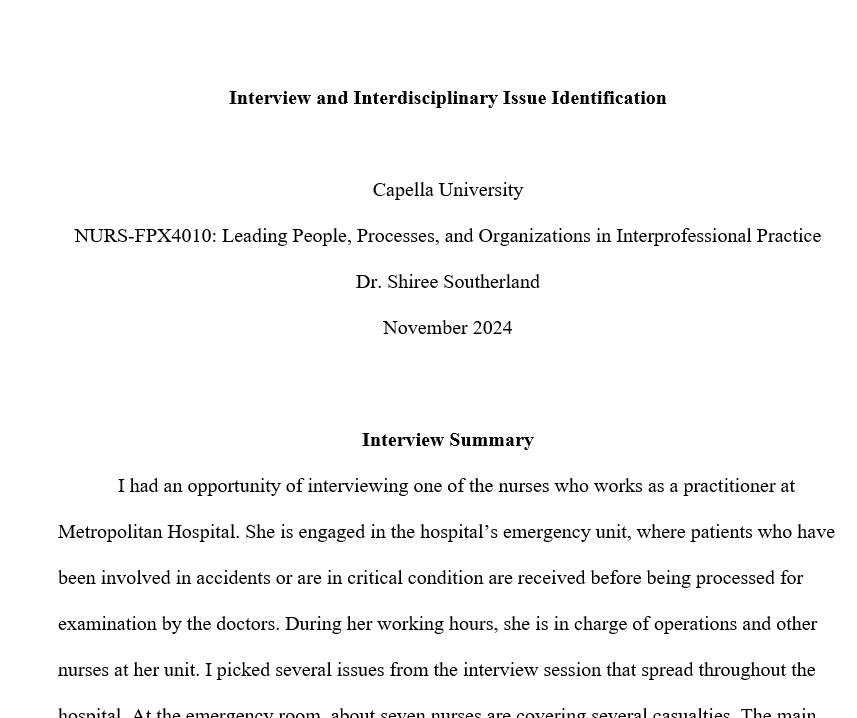NURS-FPX4010_P_Assessment 2-1 Solution.docx
Interview and Interdisciplinary Issue Identification
Capella University
NURS-FPX4010: Leading People, Processes, and Organizations in Interprofessional Practice
Dr. Shiree Southerland
November 2024
Interview Summary
I had an opportunity of interviewing one of the nurses who works as a practitioner at Metropolitan Hospital. She is engaged in the hospital’s emergency unit, where patients who have been involved in accidents or are in critical condition are received before being processed for examination by the doctors. During her working hours, she is in charge of operations and other nurses at her unit.
I picked several issues from the interview session that spread throughout the hospital. At the emergency room, about seven nurses are covering several casualties. The main problem involves assigning nurses in the emergency room to other units, like critical care, without authorization from the unit leader.
Thus, in most cases, there are only two nurses in the emergency room when the recommended number should be seven nurses. It leads to an overload of available nurses, causing long queues in the emergency room.
Although the hospital’s management is reluctant to address these concerns, which contributes to poor healthcare delivery. Ideally, nurses in the emergency room work long hours and attend to more casualties beyond their capacity.
I also picked communication issues, especially between young nurses and older nurses. Older nurses tend to withhold key information from junior nurses even though they are supposed to offer leadership and guidance to younger nurses. This issue can be classified as a disciplinary issue since it involves a breach of contract.
The main problem comes when the hospital cannot avail enough resources for use by all nurses, thus forcing some of the nurses, especially senior nurses, to ignore junior nurses while distributing such items. The interdisciplinary team’s role is to ensure equitable distribution of items within the hospital to support all staff members.
Issue Identification
There is a huge staff shortage and funding at the hospital, which is detrimental to the operations of the facility and a risk to the well-being of patients admitted to the hospital. The workload at the emergency room is a concern because patients take much time to be processed, despite some having critical conditions that require urgent attention. Staff overload is prone in many hospitals since the number of casualties can never be determined.
However, comprehensive management mechanisms ensure these patients receive the best care, irrespective of the situation. Metropolitan hospital applies the same approach repeatedly, and the management is adamant about improving staffing, especially in the emergency room, thus causing endless ripples in the unit.
There is a need for a progressive team approach, which may involve engaging student graduates, incorporating externship programs, improving work culture, and identifying innovative ways of solving the crisis (Hussain et al., 2018). Thus, it would only be fair to incorporate progressive measures to ensure that patient’s welfare remains a priority for the organization.
Change Theories that Could Lead to an Interdisciplinary Solution
Change theories are an important aspect of change agents, which are necessary for making appropriate reforms in their departments or organizations. The theories offer guidance on implementing appropriate action plans, especially concerning a desired change within the institution. Kurt Lewin’s change model prescribed a detailed implementation strategy that can be used by change agents, especially in advocating for improved services or workflow within an institution (Hussain et al., 2018).
He recommends unfreezing, changing, and refreezing concepts for application by interdisciplinary teams in finding a solution to the hospital’s staffing concerns. Addressing the overload would ultimately improve patient care delivery, thus enhancing patient safety and well-being. Hussain et al. (2018) indicated that is applying Kurt Lewis’s theory make the reform process very easy; it helps the management realign resources and functions and achieve the desired objective.
Improving Collaboration
Leadership strategies provide a comprehensive platform for implementing interdisciplinary team objectives and strategies. Clarion Court Skilled Nursing Facility can benefit from a leader who ensures a cohesive approach to solving organizational problems, especially in the health sector. Leadership reflects individuals and collective efforts within an institution to mobilize resources available to the facility to accomplish the organization’s goals.
Integrating transformative change through a transformational leadership strategy is the best leadership approach. Clarion Court Skilled Nursing Facility needs a transformational leadership style that guarantees staff members loyalty, change, and satisfaction. It is relevant to this case because a transformative leader can identify the staff shortage in some units, thus putting proper guidelines and protocols in place to address the problem.
Further, transformational leadership gives staff members a different perspective on service or delivery (McGowan & Reid, 2018). It expands the organization’s capability to achieve its objectives by simply implementing staff motivation and incentives.
The Clarion Court Skilled Nursing Facility needs a transformative leader who will ensure that all resources and staff members are aligned to their specific duties within which they can fully deliver. Additionally, effective communication, openness, transparency, and honesty help build the desired collaboration. The values are ideal for Clarion Court Skilled Nursing Facility since it allows the various teams to yield cohesiveness and the realization of set objectives.
As I conclude, nurses, administrators, nurse managers, physicians, the IT team, and relevant affiliates should cooperate to achieve a desired outcome. The group shares ideas necessary for creating and maintaining a highly responsive clinical environment (Rosenberg, 2019).
Additionally, the cooperation of interdisciplinary teams is anchored on problem-solving, critical thinking, and shared decision-making. Everyone in team anticipates problems and share accurate and complete information before they occur. The proactive commitment to maintaining a competitive clinical environment helps the organizations to maintain a superior advantage in a complex healthcare system.
References
Hussain, S. T., Lei, S., Akram, T., Haider, M. J., Hussain, S. H., & Ali, M. (2018). Kurt Lewin’s change model: A critical review of the role of leadership and employee involvement in organizational change. Journal of Innovation & Knowledge, 3(3), 123-127. https://www.sciencedirect.com/science/article/pii/S2444569X16300087
McGowan, M., & Reid, B. (2018). Using the Plan, Do, Study, Act cycle to enhance a patient feedback system for older adults. British Journal of Nursing, 27(16), 936-941. https://pubmed.ncbi.nlm.nih.gov/30187794/
Rosenberg, K. (2019). RN shortages negatively impact patient safety. American Journal of Nursing, 119(3), 51. https://pubmed.ncbi.nlm.nih.gov/30801322/



